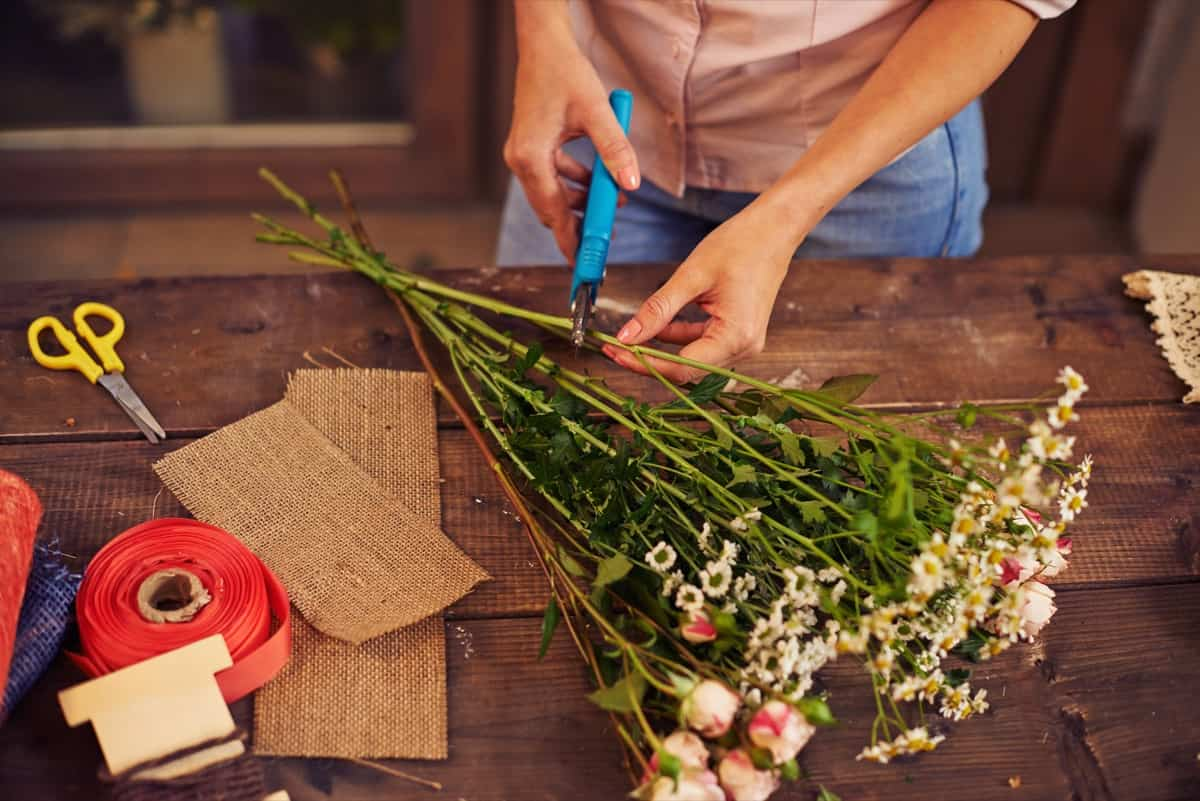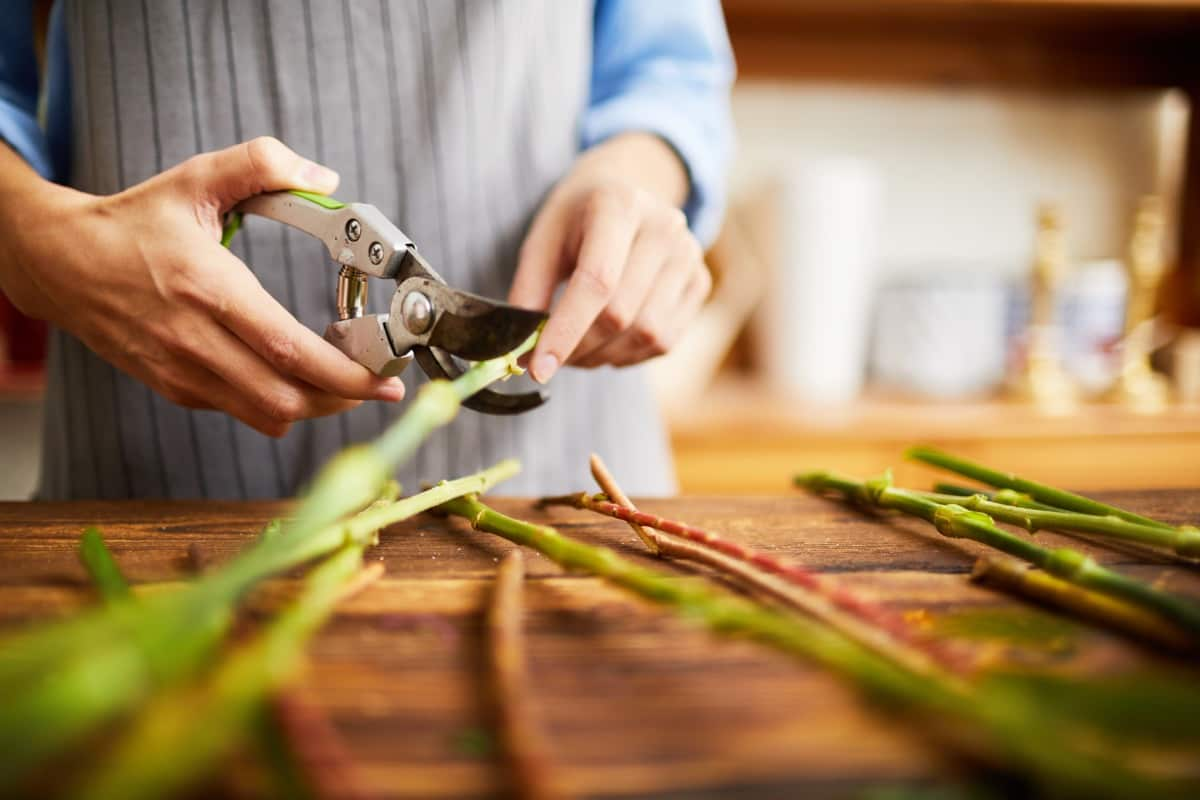Propagating plants through stem cuttings is an easy and inexpensive way to create new plants. This method involves cutting a stem section from a healthy parent plant and planting it in soil or water. The cutting will develop roots and grow into a new plant, identical to the parent plant. This method works well for many types of plants, including herbs, houseplants, and shrubs.

This article will provide a step-by-step guide on propagating plants using stem cuttings. Below we learn how to root plant stem cuttings in water, various examples, a list of plants that grow from stem cuttings, and a step-by-step guide to propagating plants using Stem Cuttings.
How to Propagate Plants Using Stem Cuttings
Choose the Right Time
When the parent plant is actively developing in the spring or summer is when cuttings should be taken. Avoid taking cuttings during hot, dry weather or when the plant is dormant. Choose a healthy plant with no signs of disease or pest infestation. The item you select should be strong and straight, with at least one set of leaves.
Prepare the Tools
You will need a sharp, sterile pair of scissors or pruning shears to take cuttings. Sterilizing your tools helps to prevent the spread of disease. You can do this by wiping them down with rubbing alcohol or dipping them in a solution of one part bleach to nine parts water.
Take the Cutting
Cut a stem 4-6 inches long, just below a node (where a leaf attaches to the stem). Take off the lowest leaves, leaving only a couple at the top of the stem. To minimize water loss, you might divide any remaining big leaves in half. If the plant has flowers or buds, remove them, as they can take energy away from root development.
Prepare the Cutting
If you want to use water to spread the cutting, you may skip this. If planting the cutting in soil, dip the cut end in rooting hormone powder. This will help the cutting to develop roots. Tap off any excess powder and plant the cutting immediately.
Plant or Place in Water
Using soil, fill a pot with potting mix and make a hole in the center. Plant the cutting in the hole, pressing the soil firmly around it. Water the cutting lightly and cover the pot with a plastic bag to create a humid environment. The planter should be exposed to strong, indirect light. To know when to water, you should routinely check the soil moisture.
If you are using water, fill a glass or jar and place the cutting in the water. Ensure that the bottom of the stem is submerged in the water, but the leaves are not touching the water. Place the glass or jar in a bright but indirect light. Every few days, you should replace the water to maintain it clean and avoid the growth of mould or germs.
Wait for Root Development
It will take several weeks for the cutting to develop roots. During this time, it is important to keep the soil or water moist but not waterlogged.
Transplant the Cutting
After a few weeks, check the cutting for root development. If you see roots growing from the bottom of the stem, it is time to transplant the cutting. If you are using soil, gently remove the plastic bag and water the cutting as needed. Once the plant has grown a few more leaves, you can transplant it into a larger pot or outside into the garden.
In case you missed it: How to Grow Pothos from Cuttings: DYI in 10 Simple Steps

If you are using water, carefully remove the cutting and rinse any remaining rooting hormone powder. Plant the cutting in soil and continue to care for it as you would a plant that was started in soil.
Tips and Tricks for Successful Propagation
- Choose healthy parent plants with no signs of disease or pest infestation.
- Take cuttings in the morning when the plant is hydrated and has the most energy.
- Use a rooting hormone powder to increase the chances of successful rooting.
- Keep the soil or water moist but not waterlogged. Too much water can cause the cutting to rot.
- If you are using soil, cover the pot with a plastic bag to create a humid environment for the cutting.
- If you are using water, change the water every few days to prevent mold or bacteria from forming.
- Avoid placing the cutting in direct sunlight, as this can cause the cutting to dry out or burn.
- Be patient! The cutting can take several weeks to develop roots and start growing.
Common Problems and Solutions
- The cutting is not rooting: If the cutting has not developed roots after several weeks, try using a rooting hormone powder or taking another cutting from a different part of the plant. Ensure that the cutting is getting enough light and the soil or water is not too wet or too dry.
- The cutting is wilting: If the leaves are wilting, it could be a sign that the cutting is not getting enough water. Check the soil moisture or the water level and adjust as needed.
- The cutting is rotting: If it starts to rot, it is likely due to too much moisture. Make sure that the soil or water is not too wet and that there is adequate drainage.
In case you missed it: How to Grow Curry Leaf Plant from Cuttings: DYI in 10 Simple Steps

Conclusion
Propagating plants using stem cuttings is a simple and rewarding way to create new plants. With a few basic tools and patience, you can easily grow a collection of plants from a single-parent plant. Whether you are an experienced gardener or just starting, propagating plants through stem cuttings is a great way to expand your plant collection and create beautiful, healthy plants. By following these steps and tips, you can successfully propagate plants and enjoy the beauty of gardening.
- Feed Your Flock for Less: Top 10 Tips to Save on Chicken Feed
- Ultimate Guide to Ossabaw Island Hog: Breeding, Raising, Diet, and Care
- Hatching Answers: The Top 10 Reasons Your Chickens Aren’t Laying Eggs
- Eggs and Economics: Breaking Down the Cost of Raising Backyard Chickens
- Defend Your Greens: Proven Methods to Keep Iguanas Out of Your Garden
- Ultimate Guide to Cinnamon Queen Chicken: A Comprehensive Guide for Beginners
- Ultimate Guide to California Tan Chicken: Breeding, Raising, Diet, Egg-Production and Care
- Ultimate Guide to Marsh Daisy Chicken: Breeding, Raising, Diet, and Care
- 10 Types of Chicken Farming Businesses You Can Start for Profits